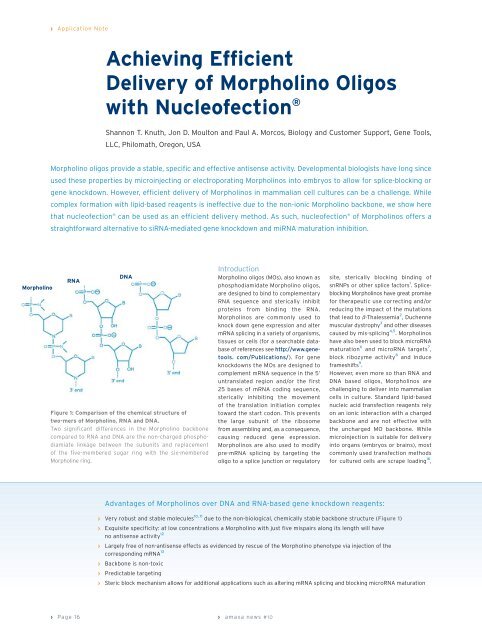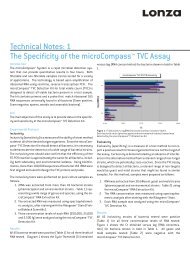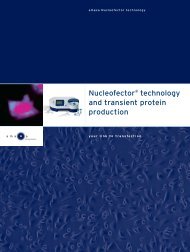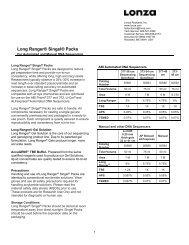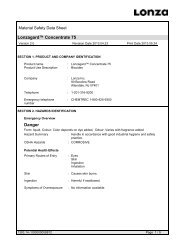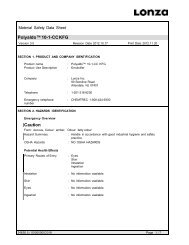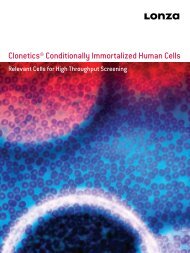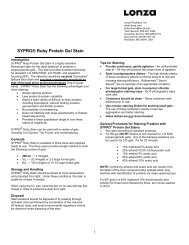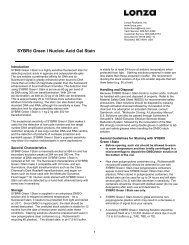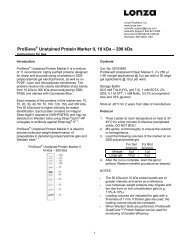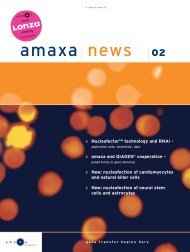amaxa news #10 - Lonza AG
amaxa news #10 - Lonza AG
amaxa news #10 - Lonza AG
You also want an ePaper? Increase the reach of your titles
YUMPU automatically turns print PDFs into web optimized ePapers that Google loves.
Morpholino<br />
› Application Note<br />
Achieving Efficient<br />
Delivery of Morpholino Oligos<br />
with Nucleofection ®<br />
Shannon T. Knuth, Jon D. Moulton and Paul A. Morcos, Biology and Customer Support, Gene Tools,<br />
LLC, Philomath, Oregon, USA<br />
Morpholino oligos provide a stable, specific and effective antisense activity. Developmental biologists have long since<br />
used these properties by microinjecting or electroporating Morpholinos into embryos to allow for splice-blocking or<br />
gene knockdown. However, efficient delivery of Morpholinos in mammalian cell cultures can be a challenge. While<br />
complex formation with lipid-based reagents is ineffective due to the non-ionic Morpholino backbone, we show here<br />
that nucleofection ® can be used as an efficient delivery method. As such, nucleofection ® of Morpholinos offers a<br />
straightforward alternative to siRNA-mediated gene knockdown and miRNA maturation inhibition.<br />
RNA<br />
DNA<br />
Figure 1: Comparison of the chemical structure of<br />
two-mers of Morpholino, RNA and DNA.<br />
Two significant differences in the Morpholino backbone<br />
compared to RNA and DNA are the non-charged phosphodiamiate<br />
linkage between the subunits and replacement<br />
of the five-membered sugar ring with the six-membered<br />
Morpholine ring.<br />
Introduction<br />
Morpholino oligos (MOs), also known as<br />
phosphodiamidate Morpholino oligos,<br />
are designed to bind to complementary<br />
RNA sequence and sterically inhibit<br />
proteins from binding the RNA.<br />
Morpholinos are commonly used to<br />
knock down gene expression and alter<br />
mRNA splicing in a variety of organisms,<br />
tissues or cells (for a searchable database<br />
of references see http://www.genetools.<br />
com/Publications/). For gene<br />
knockdowns the MOs are designed to<br />
complement mRNA sequence in the 5’<br />
untranslated region and/or the first<br />
25 bases of mRNA coding sequence,<br />
sterically inhibiting the movement<br />
of the translation initiation complex<br />
toward the start codon. This prevents<br />
the large subunit of the ribosome<br />
from assembling and, as a consequence,<br />
causing reduced gene expression.<br />
Morpholinos are also used to modify<br />
pre-mRNA splicing by targeting the<br />
oligo to a splice junction or regulatory<br />
Advantages of Morpholinos over DNA and RNA-based gene knockdown reagents:<br />
› Very robust and stable molecules 10, 11 due to the non-biological, chemically stable backbone structure (Figure 1)<br />
› Exquisite specificity: at low concentrations a Morpholino with just five mispairs along its length will have<br />
no antisense activity 12<br />
› Largely free of non-antisense effects as evidenced by rescue of the Morpholino phenotype via injection of the<br />
corresponding mRNA 13<br />
› Backbone is non-toxic<br />
› Predictable targeting<br />
› Steric block mechanism allows for additional applications such as altering mRNA splicing and blocking microRNA maturation<br />
› Page 16 › <strong>amaxa</strong> <strong>news</strong> # 10<br />
site, sterically blocking binding of<br />
snRNPs or other splice factors 1 . Spliceblocking<br />
Morpholinos have great promise<br />
for therapeutic use correcting and/or<br />
reducing the impact of the mutations<br />
that lead to b -Thalessemia 2 , Duchenne<br />
muscular dystrophy 3 and other diseases<br />
caused by mis-splicing 4,5 . Morpholinos<br />
have also been used to block microRNA<br />
maturation 6 and microRNA targets 7 ,<br />
block ribozyme activity 8 and induce<br />
frameshifts 9 .<br />
However, even more so than RNA and<br />
DNA based oligos, Morpholinos are<br />
challenging to deliver into mammalian<br />
cells in culture. Standard lipid-based<br />
nucleic acid transfection reagents rely<br />
on an ionic interaction with a charged<br />
backbone and are not effective with<br />
the uncharged MO backbone. While<br />
microinjection is suitable for delivery<br />
into organs (embryos or brains), most<br />
commonly used transfection methods<br />
for cultured cells are scrape loading 16 ,


